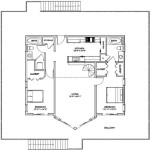How to Find the Building Plans For Your House
Locating the building plans for a house can be a valuable endeavor, whether for renovation projects, historical research, or simply understanding the structural integrity of the property. These plans, often referred to as blueprints or architectural drawings, provide detailed information about the house's design, dimensions, materials, and construction methods. The process of finding these plans can vary depending on the age of the house, its location, and the record-keeping practices of the relevant authorities and builders. This article provides a comprehensive guide to navigate the various avenues available for locating residential building plans.
Consulting Previous Owners and Real Estate Professionals
One of the first steps in the search for building plans should involve reaching out to previous owners of the property. Previous homeowners might have retained copies of the blueprints from when the house was built or during any subsequent remodeling projects. Contacting them directly, or through a real estate agent who handled the sale of the property, can sometimes yield positive results. It is prudent to inquire about any documents they might possess related to the house’s construction or renovation history.
Real estate agents involved in the sale of the house, even if they are not the direct contact with the previous owners, can also be a valuable resource. Their records may contain information about the original builder or architect, which can be instrumental in tracking down the plans. They may also have access to property disclosure documents that indicate whether building plans were previously available or mentioned.
When contacting previous owners or real estate professionals, it's important to be clear about the specific information being sought. Providing the property address, the approximate year of construction, and any known renovation dates can assist them in locating relevant documents. Being courteous and respectful of their time is crucial in ensuring a cooperative response.
Searching Local Government Archives and Building Departments
Local government archives and building departments are often the primary repositories for residential building plans. These departments are responsible for reviewing and approving building permits, and the submitted plans are often kept on file. The process of accessing these records can vary depending on the specific locality, but it generally involves submitting a formal request to the relevant department.
The first step is to identify the appropriate local government agency. This is typically the city or county building department or planning department. Contacting the department directly, either by phone or online, can help clarify the specific procedures for requesting building plans. Many departments now offer online databases or search tools that allow for preliminary searches of available records. These databases may require information such as the property address, parcel number, or the names of previous owners.
If an online search is not fruitful, submitting a formal request to the building department is usually necessary. This request should include detailed information about the property, including its address, legal description, and the reason for requesting the plans. It is also helpful to specify the exact type of documents being sought, such as architectural drawings, structural plans, or electrical diagrams. The department may require a fee for searching and retrieving the records, and it is important to inquire about the associated costs and payment methods.
Once the request is submitted, the building department will typically conduct a search of their archives. The availability of building plans can depend on several factors, including the age of the house, the record-keeping practices of the department, and whether the plans were ever officially submitted. Older houses may have plans that are stored in physical archives, requiring manual retrieval. Newer houses are more likely to have digitized records that are more easily accessible.
In some cases, the building department may have incomplete or partial plans. This could be due to loss, damage, or the original submission being incomplete. It is important to be prepared for the possibility that the complete set of plans may not be available.
Investigating Historical Societies and Local Libraries
Historical societies and local libraries can be valuable resources for locating building plans, particularly for older houses or those with historical significance. These institutions often maintain archives of historical documents, including maps, property records, and architectural drawings. Their collections may contain building plans that are not available through government agencies or other sources.
Historical societies are typically focused on preserving the history of a specific locality or region. They may have collections of historical photographs, documents, and artifacts related to local buildings and architecture. Contacting the historical society in the area where the house is located can provide access to their collections and expertise. They may have building plans that were donated by previous owners, architects, or builders. The society's staff may also be able to provide information about the architectural history of the area and suggest other potential sources for finding the plans.
Local libraries, particularly those with extensive local history collections, can also be helpful. They may have published books, articles, and maps that provide information about the history of the house or its neighborhood. They may also have access to digitized archives of historical documents, including building plans. Library staff can assist in searching these resources and identifying relevant materials. Some libraries may also have microfilm or microfiche copies of building permits or other records that contain building plans.
When researching historical societies and local libraries, it is important to be specific about the information being sought. Providing the property address, the approximate year of construction, and any known historical details can help the staff narrow their search. It is also helpful to be prepared to conduct some independent research, as the availability of building plans can vary widely depending on the institution and the specific collection.
Contacting Architects and Builders
If the name of the original architect or builder is known, they may have retained copies of the building plans. Even if the original architect or builder is no longer in business, their firm may still exist or their records may have been transferred to another firm. Contacting architects and builders is a direct approach that can potentially yield the most complete and accurate set of building plans.
The first step is to identify the original architect or builder. This information may be found in historical records, old building permits, or property deeds. Local historical societies or building departments may also be able to provide this information. Once the name of the architect or builder is known, their contact information can be searched online or through professional directories.
When contacting the architect or builder, it is important to be clear about the specific information being sought. Providing the property address, the approximate year of construction, and any relevant details about the house's design can help them locate the plans. It is also important to be polite and respectful of their time, as they may not be obligated to provide the plans. They may charge a fee for retrieving and copying the plans, and it is important to inquire about the associated costs and payment methods.
If the original architect or builder is no longer in business, their firm may have been acquired by another firm. In this case, the records of the original firm may have been transferred to the acquiring firm. Contacting the acquiring firm can provide access to these records. Professional associations of architects and builders can sometimes provide information about the history of architectural firms and their potential successors.
Even if the original architect or builder cannot be located, there may be other architects or builders in the area who are familiar with the style of the house and may have access to similar plans. Contacting these professionals can provide insights into the house's construction methods and potential design features. They may also be able to recommend other resources for finding the building plans.
Exploring Online Resources and Databases
The internet has become an increasingly valuable resource for finding building plans. Several online databases and websites specialize in providing access to architectural drawings and property records. These resources can be particularly helpful for locating plans for older houses or those located in areas with limited public records.
Numerous websites offer access to historical maps, property records, and architectural drawings. Some of these websites are free, while others require a subscription fee. These websites often aggregate data from various sources, including government agencies, historical societies, and private collections. Searching these websites using the property address and other relevant information can sometimes lead to the discovery of building plans or related documents.
Online databases of building permits can also be helpful. Many local government agencies now offer online access to their building permit records. These databases may contain building plans or at least references to building plans that were submitted as part of the permit application. Searching these databases using the property address and permit dates can potentially uncover valuable information.
Architectural websites and online forums can also be valuable resources. Many architects and building professionals share their work online, and some may have access to historical building plans. These websites and forums can provide a platform for asking questions and connecting with professionals who may be able to assist in the search. It is important to be cautious when using online resources and to verify the accuracy of any information that is found.
When using online resources, it is important to be specific about the information being sought. Using relevant keywords and search terms can help narrow the results and increase the chances of finding the desired plans. It is also important to be aware of the limitations of online resources and to cross-reference any information that is found with other sources.
Finding the building plans for a house can be a challenging but rewarding process. By exploring the various avenues described in this article, individuals can increase their chances of locating these valuable documents and gaining a deeper understanding of their property's history and construction.

How To Find Building Plans For My House Architecture Design Plan

Where You Can Buy House Plans Live Home 3d

How To Read A Floor Plan With Dimensions Houseplans Blog Com

How To Get Blueprints Of Your House

Building Plans For Your House My Modern Architects Upwork

How To Read A Floor Plan With Dimensions Houseplans Blog Com

House Plans How To Design Your Home Plan

Building Plans For Your House My Modern Architects Upwork

How To Read House Plans Elevations

Free House Design Home And Plans
Related Posts








